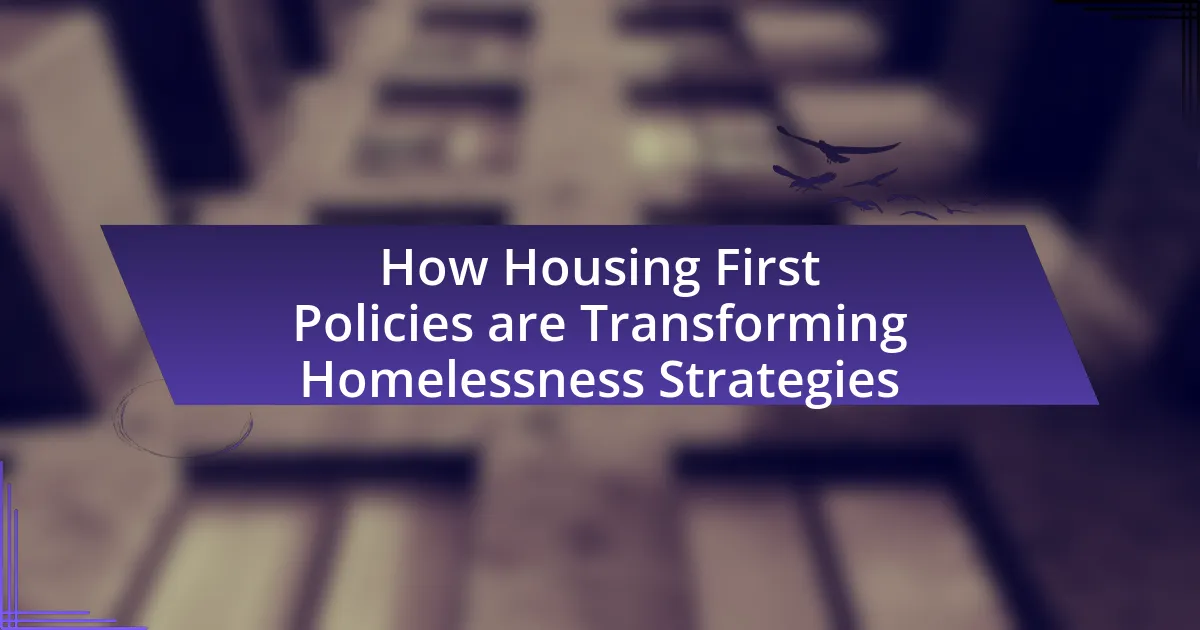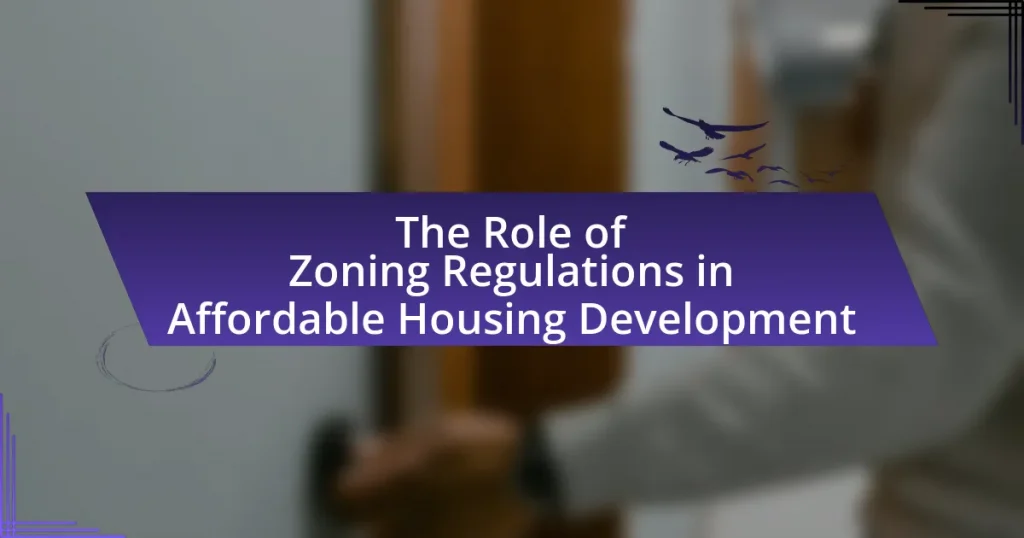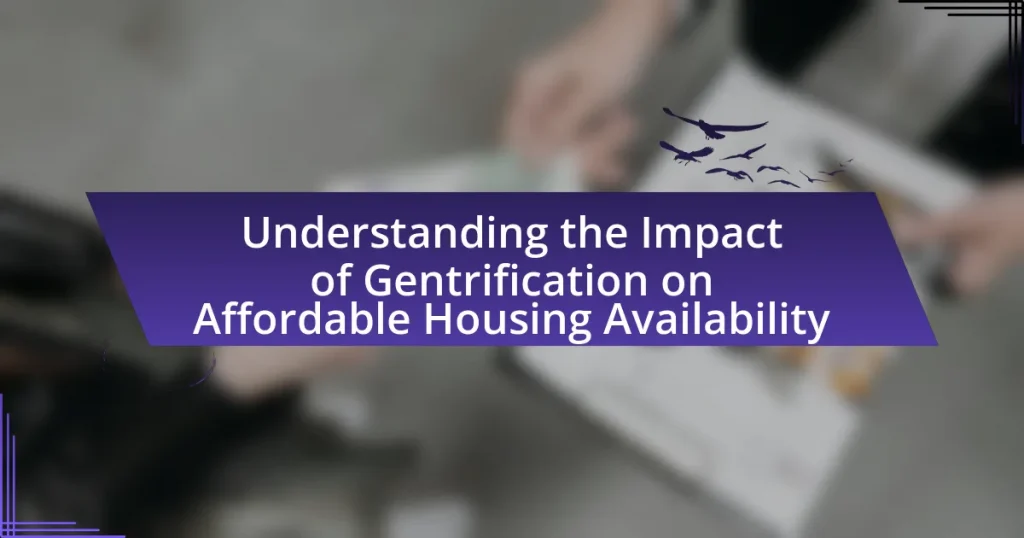Housing First Policies are innovative strategies designed to provide permanent housing to homeless individuals without preconditions such as sobriety or employment. This article examines how these policies differ from traditional homelessness strategies, emphasizing immediate access to housing and the provision of supportive services tailored to individual needs. It highlights the principles underpinning Housing First, the evidence supporting its effectiveness in reducing homelessness rates, and the transformative impact on community approaches to homelessness. Additionally, the article discusses the challenges cities face in implementing these policies, the role of community partnerships, and the future implications of Housing First strategies in addressing homelessness comprehensively and sustainably.

What are Housing First Policies?
Housing First Policies are strategies aimed at providing permanent housing to homeless individuals without preconditions such as sobriety or employment. These policies prioritize immediate access to housing, followed by supportive services to address health, employment, and social integration needs. Research has shown that Housing First approaches significantly reduce homelessness and improve overall well-being, with studies indicating that 80% of participants remain housed after two years.
How do Housing First Policies differ from traditional homelessness strategies?
Housing First Policies prioritize providing permanent housing to individuals experiencing homelessness without preconditions, while traditional homelessness strategies often require individuals to meet certain criteria, such as sobriety or participation in treatment programs, before receiving housing. Research indicates that Housing First approaches lead to higher rates of housing stability, with studies showing that 80-90% of participants remain housed after one year, compared to lower retention rates in traditional models that emphasize transitional housing and conditional support. This fundamental shift in focus from treatment first to housing first represents a significant departure from conventional methods, emphasizing the importance of stable housing as a foundation for addressing other issues related to homelessness.
What principles underpin Housing First Policies?
Housing First Policies are underpinned by several key principles, including immediate access to permanent housing, the belief that housing is a human right, and the provision of supportive services tailored to individual needs. These principles emphasize that individuals experiencing homelessness should be provided with stable housing without preconditions, such as sobriety or participation in treatment programs. Research indicates that this approach leads to improved housing stability and better overall well-being for participants, as evidenced by studies showing that Housing First initiatives significantly reduce homelessness rates and improve mental health outcomes.
Why is immediate access to housing prioritized in these policies?
Immediate access to housing is prioritized in these policies because it effectively addresses homelessness by providing stability and a foundation for individuals to rebuild their lives. Research indicates that stable housing significantly improves mental health, reduces substance abuse, and enhances overall well-being, as evidenced by studies showing that 80% of participants in Housing First programs maintained their housing after two years. This approach contrasts with traditional methods that often require individuals to meet certain conditions before receiving housing, which can prolong their homelessness and exacerbate their challenges.
What evidence supports the effectiveness of Housing First Policies?
Housing First Policies are supported by substantial evidence demonstrating their effectiveness in reducing homelessness and improving housing stability. Studies, such as the one conducted by the National Alliance to End Homelessness, show that Housing First approaches lead to a 70% reduction in homelessness among participants compared to traditional methods. Additionally, a meta-analysis published in the American Journal of Psychiatry found that individuals in Housing First programs experienced significantly lower rates of substance abuse and improved mental health outcomes. These findings underscore the efficacy of Housing First Policies in addressing homelessness comprehensively and sustainably.
How have Housing First initiatives impacted homelessness rates?
Housing First initiatives have significantly reduced homelessness rates by providing stable housing without preconditions. Studies show that cities implementing Housing First models, such as Salt Lake City and Finland, have seen reductions in chronic homelessness by over 90% and overall homelessness rates drop by 30% respectively. These initiatives prioritize immediate access to housing, which leads to improved health outcomes and decreased reliance on emergency services, further validating their effectiveness in addressing homelessness.
What success stories illustrate the benefits of Housing First Policies?
Success stories illustrating the benefits of Housing First Policies include the implementation in Salt Lake City, Utah, where chronic homelessness was reduced by 91% between 2005 and 2015 through the provision of permanent housing without preconditions. Another example is the Pathways to Housing program in New York City, which demonstrated that 85% of participants remained housed after two years, significantly decreasing emergency service usage and improving overall health outcomes. These cases provide concrete evidence that Housing First approaches effectively reduce homelessness and enhance the well-being of individuals.
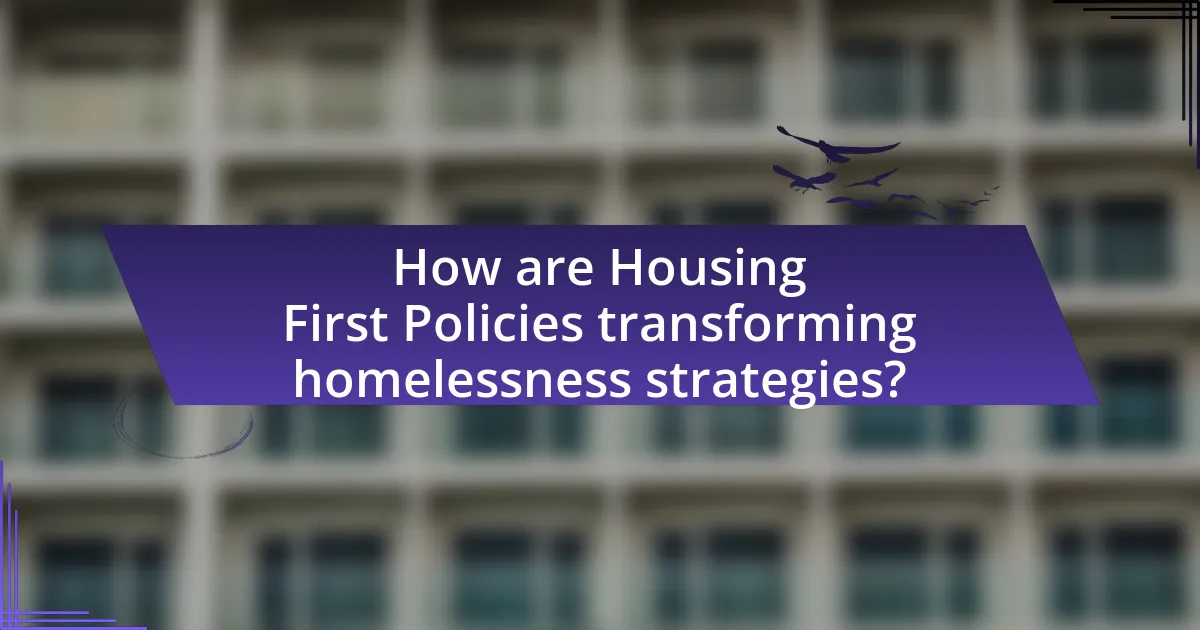
How are Housing First Policies transforming homelessness strategies?
Housing First Policies are transforming homelessness strategies by prioritizing immediate access to permanent housing without preconditions. This approach has been shown to significantly reduce homelessness rates, as evidenced by a study conducted by the National Alliance to End Homelessness, which reported that communities implementing Housing First saw a 30% decrease in chronic homelessness. Additionally, these policies improve overall well-being and stability for individuals, as they provide a foundation for accessing supportive services, leading to better health outcomes and increased employment opportunities.
What changes in approach are seen in cities adopting Housing First Policies?
Cities adopting Housing First Policies shift their approach from a traditional model of addressing homelessness, which often prioritizes temporary shelters and services contingent on sobriety or employment, to a model that provides permanent housing as the first step. This change emphasizes immediate access to stable housing without preconditions, recognizing that housing stability is essential for individuals to address other challenges such as health issues or joblessness. Evidence from various cities shows that this approach leads to higher rates of housing retention, reduced reliance on emergency services, and improved overall well-being for formerly homeless individuals. For instance, a study in Salt Lake City found that the implementation of Housing First resulted in a 91% reduction in chronic homelessness, demonstrating the effectiveness of this policy shift.
How do these policies influence funding and resource allocation?
Housing First policies significantly influence funding and resource allocation by prioritizing permanent housing solutions for the homeless, which reallocates resources from temporary shelters to long-term housing initiatives. This shift in focus encourages governments and organizations to invest in supportive services, such as mental health care and job training, that accompany housing stability. For instance, studies have shown that communities implementing Housing First strategies experience reduced costs associated with emergency services and healthcare, as stable housing leads to improved health outcomes and decreased reliance on crisis interventions. This evidence supports the notion that funding directed towards Housing First initiatives not only addresses immediate housing needs but also fosters sustainable solutions that enhance overall community well-being.
What role do community partnerships play in implementing Housing First strategies?
Community partnerships are essential in implementing Housing First strategies as they provide the necessary resources, support, and collaboration needed to effectively address homelessness. These partnerships facilitate access to a range of services, including healthcare, employment, and social support, which are critical for the success of Housing First initiatives. For instance, studies have shown that communities with strong partnerships between local governments, non-profits, and service providers experience higher rates of successful housing placements and improved outcomes for individuals transitioning out of homelessness. This collaborative approach not only enhances service delivery but also fosters a more comprehensive understanding of the needs of the homeless population, leading to more effective and sustainable solutions.
What challenges do cities face when implementing Housing First Policies?
Cities face several challenges when implementing Housing First policies, primarily including funding constraints, community opposition, and the need for supportive services. Funding constraints arise because Housing First initiatives often require significant upfront investment for housing and ongoing support services, which can be difficult to secure in tight municipal budgets. Community opposition, or NIMBYism (Not In My Backyard), can hinder the establishment of housing projects as residents may resist the integration of formerly homeless individuals into their neighborhoods. Additionally, the successful implementation of Housing First policies necessitates a robust network of supportive services, such as mental health care and job training, which may be lacking or underfunded in many cities. These challenges can impede the effectiveness and sustainability of Housing First approaches in addressing homelessness.
How can resistance from stakeholders be addressed?
Resistance from stakeholders can be addressed through effective communication and engagement strategies. By actively involving stakeholders in the decision-making process, their concerns can be acknowledged and addressed, fostering a sense of ownership and collaboration. Research indicates that when stakeholders are engaged early and provided with transparent information, their resistance decreases significantly. For example, a study by the Urban Institute found that inclusive stakeholder engagement in policy development leads to higher acceptance rates of new initiatives, particularly in social services like homelessness strategies.
What are the common misconceptions about Housing First approaches?
Common misconceptions about Housing First approaches include the belief that they enable homelessness or that they do not require any accountability from participants. In reality, Housing First prioritizes providing stable housing without preconditions, which has been shown to reduce homelessness effectively. Research indicates that programs implementing Housing First have led to significant decreases in the number of individuals experiencing homelessness, with studies such as the 2016 evaluation by the U.S. Interagency Council on Homelessness demonstrating that 80% of participants remained housed after one year. Additionally, while Housing First does not impose sobriety or treatment requirements, it encourages participants to engage in supportive services, fostering accountability and personal responsibility.
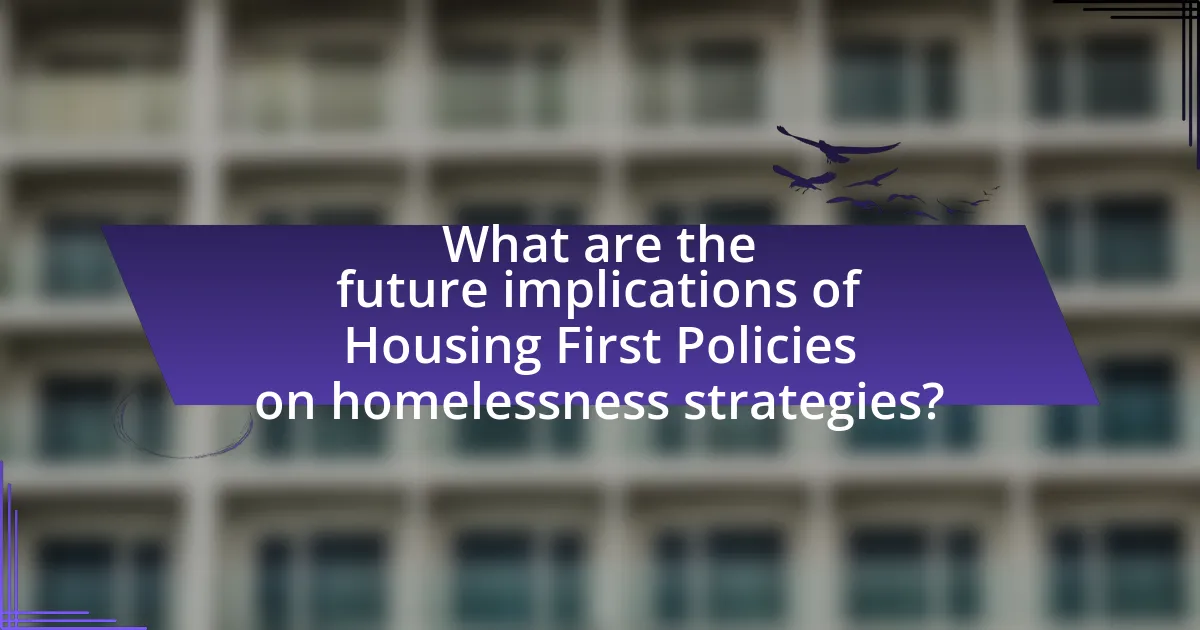
What are the future implications of Housing First Policies on homelessness strategies?
Housing First Policies are likely to lead to a more effective and sustainable approach to homelessness strategies in the future. By prioritizing immediate access to permanent housing without preconditions, these policies have demonstrated a significant reduction in homelessness rates. For instance, studies show that cities implementing Housing First have seen decreases in chronic homelessness by up to 90%, as evidenced by the success of programs in places like Utah and Finland. Furthermore, these policies can reduce costs associated with emergency services and healthcare, as stable housing leads to improved health outcomes and decreased reliance on public resources. As more jurisdictions adopt Housing First, the implications include a shift towards comprehensive support services that address underlying issues such as mental health and substance abuse, ultimately transforming the landscape of homelessness strategies.
How might Housing First Policies evolve in response to changing societal needs?
Housing First Policies may evolve by integrating supportive services that address emerging societal issues such as mental health, substance abuse, and economic instability. As homelessness becomes increasingly linked to these factors, policies will likely adapt to provide comprehensive care alongside housing solutions. For instance, studies indicate that individuals experiencing homelessness often face co-occurring disorders; thus, incorporating mental health and addiction services into Housing First initiatives can enhance their effectiveness. Additionally, as economic conditions fluctuate, policies may incorporate job training and financial literacy programs to promote long-term stability for formerly homeless individuals. This evolution reflects a responsive approach to the complexities of homelessness, ensuring that Housing First remains relevant and effective in addressing the diverse needs of the population it serves.
What innovations could enhance the effectiveness of Housing First initiatives?
Innovations that could enhance the effectiveness of Housing First initiatives include the integration of supportive services tailored to individual needs, such as mental health care, substance abuse treatment, and job training programs. These services address the underlying issues that contribute to homelessness, thereby increasing the likelihood of sustained housing stability. Research indicates that programs incorporating comprehensive support services alongside housing can reduce the rate of homelessness by up to 80%, as evidenced by studies conducted by the National Alliance to End Homelessness. Additionally, leveraging technology for data collection and analysis can improve service delivery and resource allocation, ensuring that interventions are timely and effective.
How can data and technology support the implementation of Housing First Policies?
Data and technology can significantly support the implementation of Housing First policies by enabling targeted resource allocation and enhancing service delivery. For instance, data analytics can identify the specific needs of homeless populations, allowing organizations to tailor interventions effectively. Additionally, technology platforms can facilitate real-time communication among service providers, ensuring that individuals receive timely support. A study by the National Alliance to End Homelessness highlights that cities utilizing data-driven approaches have seen a 30% reduction in homelessness rates, demonstrating the effectiveness of integrating data and technology in these policies.
What best practices can be adopted for successful Housing First implementation?
Successful Housing First implementation requires a commitment to providing immediate access to permanent housing without preconditions. Key best practices include ensuring a robust support system that offers comprehensive services such as mental health care, substance use treatment, and job training, which are essential for maintaining housing stability. Research indicates that programs employing these practices, like the Pathways Housing First model, have shown significant reductions in homelessness and improved quality of life for participants. Additionally, fostering collaboration among various stakeholders, including government agencies, non-profits, and community organizations, enhances resource sharing and service delivery, further supporting successful outcomes.
How can cities measure the success of their Housing First strategies?
Cities can measure the success of their Housing First strategies by tracking key performance indicators such as housing retention rates, reductions in homelessness, and improvements in health and social outcomes. For instance, studies have shown that Housing First programs can achieve housing retention rates of 80% or higher, indicating effective long-term housing stability. Additionally, cities can analyze data on emergency service usage, which often decreases as individuals secure stable housing, further demonstrating the program’s impact on reducing homelessness and associated costs.
What role does ongoing support play in the sustainability of Housing First outcomes?
Ongoing support is crucial for the sustainability of Housing First outcomes as it ensures that individuals maintain their housing and improve their overall well-being. Research indicates that consistent access to services such as mental health care, substance use treatment, and social support significantly reduces the likelihood of returning to homelessness. For instance, a study by the National Alliance to End Homelessness found that participants receiving ongoing support had a 90% retention rate in permanent housing after two years, compared to lower rates among those without such support. This evidence underscores the importance of ongoing assistance in fostering stability and enhancing the effectiveness of Housing First initiatives.
